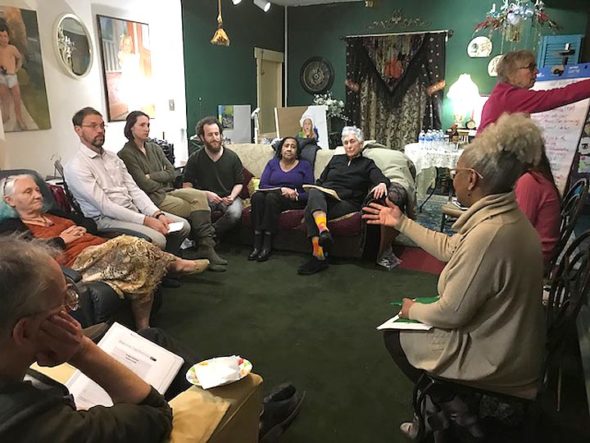
The YS Community Foundation Encore Miller Fellows helped support the Courageous Conservations series, organized by The 365 Project and the Yellow Springs Havurah to address issues of race. Here, one local group met earlier this year. From left is David Seitz, Vivian Markley, Kirk Weigand, Megan Bachman, Mori Rothman, Karen McKee, Moya Shea, Marianne MacQueen, Lauren Heaton (obscured), and Locksley Orr. Also participating in the group was Rich Bullock and Encore Miller Fellow Jalyn Roe, who co-facilitated with MacQueen. A new round of Courageous Conversations is starting up in the fall. Those interested in participating should contact Encore Miller Fellow Len Kramer at len2654@gmail.com, or 937-572-4840. (Submitted photo)
Inside Collaborative Community — The power of positive stories
- Published: August 15, 2019
This is the fifth and final update from the Encore Miller Fellows on the collaborative efforts at the nexus of college and village.
By Scott Geisel
I hope you’ll let me tell you a story. I came late to the Encores. In the fall of 2018, the Yellow Springs Community Foundation hired four individuals to help enhance connections and opportunities for interaction among our community students, seniors and nonprofits. I joined the others late in November, especially to help the group focus on stories and creative endeavors.
The Encores have done a lot since then. We’ve heard a lot of stories, and we’ve told a lot of stories, to ourselves and others, about our work. Those stories are important. Stories are part of the human condition. They help to tell us who we are, who we are not and who we want to become. Stories can evoke existential questions that may have profound effects on our lives and the lives of others.
But stories are also elusive. They change. They can be manipulated and distorted. They can be used for good or bad, or for no particular purpose at all, and still have ripple effects. And all of those things can happen with stories, without us even intending to do them.
In my work as an Encore, I have heard stories of Antioch College. Of Nolan and Richard Miller, whose bequest to the Yellow Springs Community Foundation enhanced a legacy of community collaboration. Of local nonprofits’ origins and missions, students’ lives and expectations and our village. Some of those are good stories. Some are not so good. They are all real, and yet, they are all also subjective.
A good story can become less positive when told through anger, disassociation or oppression. Or a bad story can lead to something better — for example, when it is used to think about how to get to a better place. Several members of the village have experienced this recently through the Courageous Conversations hosted by The 365 Project and the Yellow Springs Havurah. Those conversations began with stories, and they culminated with visions of what might be done to make the village a better place. That means making us, the people of the village, better in some ways. More tolerant, maybe, or more patient, or more able to understand the views and experiences of others. More willing to listen to others’ stories.
Yellow Springers have lots of stories. Some are happy, and some are not. Some are stories of anger, oppression, racism, disagreement, tension and disillusionment. Other stories are of joy, triumph, coming together, overcoming odds and peace. We are nice to each other, and we are not. We are pleased and accepting of others, and we are not. And we tell those stories. All of those stories are real, and all of them intermingle in our lives and are a part of creating the situations we live in as a community.
This calls to mind a psychological effect, known as the Michelangelo phenomenon. This particular effect has been observed between romantic couples. The general idea is that when you affirm the best qualities you observe or want to experience from your partner, that person responds by becoming more and more like those best qualities.
But perhaps this phenomenon has some effect not just on close romantic partners, but also in some way on any of us, and stories are one way that we help create our interactions, our tolerances and intolerances, our kindnesses and insensitivities. Perhaps remembering to tell good stories about ourselves and others can be some small part of creating that better village of people that the Courageous Conversations have envisioned.
Can you remember when members of the Yellow Springs community didn’t like each other, when something pulled us apart and made us think less of each other? But can you also remember when we believed in each other, when we tried to see past our differences, when positive became part of a story that didn’t seem like it had an upside?
Henry David Thoreau said this well a long time ago. His use of gender is dated, but the idea is not: “I know of no more encouraging fact than the unquestionable ability of man to elevate his life by a conscious endeavor. It is something to be able to paint a particular picture, or to carve a statue, and so to make a few objects beautiful; but it is far more glorious to carve and paint the very atmosphere and medium through which we look, which morally we can do. To affect the quality of the day, that is the highest of arts.”
Living in this village, and working in it as a member of the Encore team, has reminded me that stories are a part of that highest of arts. They can help remind us of who we are and who we want to be.
*The writer is an Encore Miller Fellow for creativity and story.
The Yellow Springs News encourages respectful discussion of this article.
You must login to post a comment.
Don't have a login? Register for a free YSNews.com account.













No comments yet for this article.